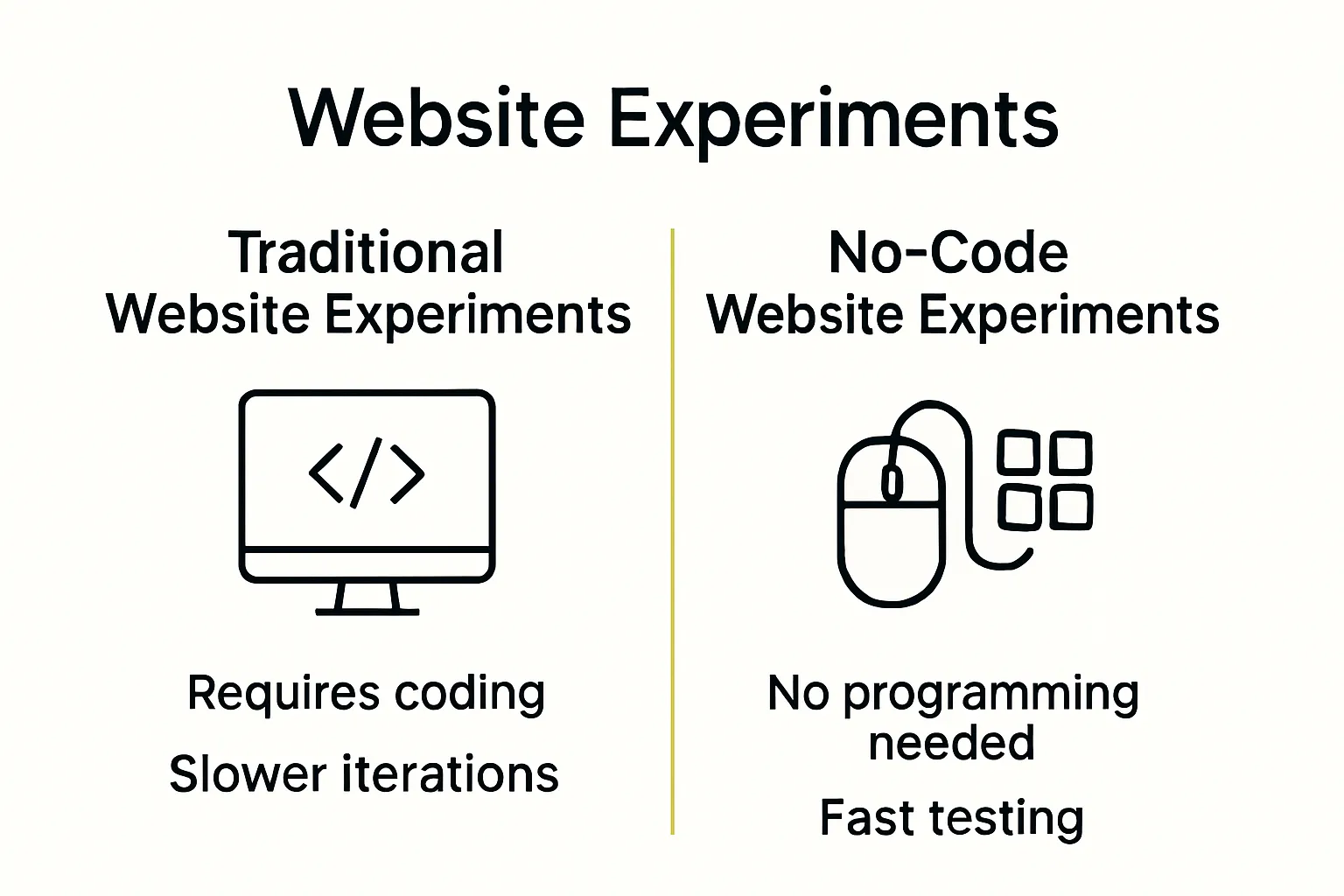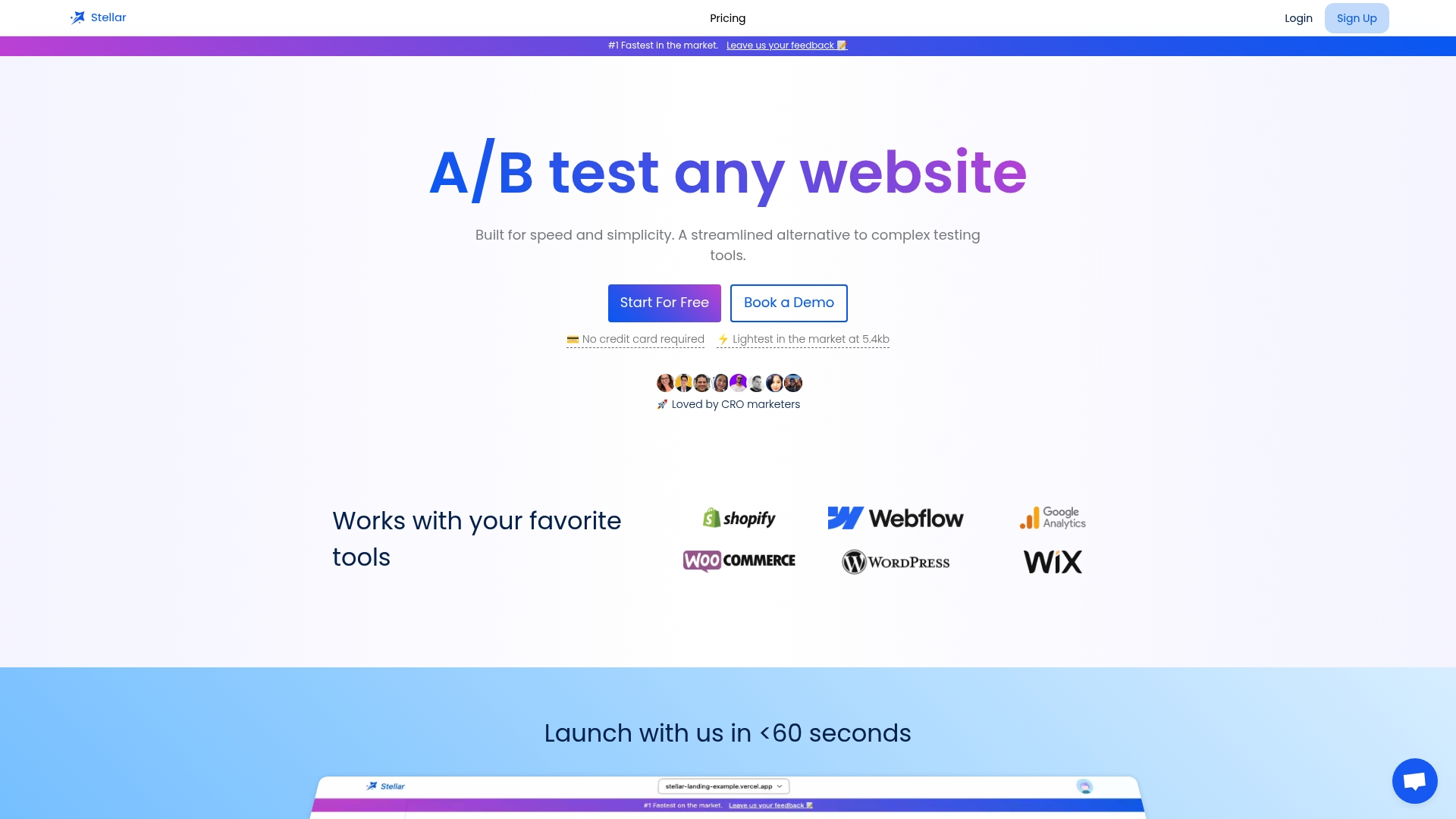
Understanding No-Code Website Experiments and Their Impact

Website changes used to mean waiting for weeks on development queues and never-ending email chains. Now, with no-code website experiments, something radical is happening. Marketers are running their own A/B tests and making live website changes without writing a single line of code. This flips the script and puts the power to grow digital results in the hands of those who know the customer best—often in just minutes.
Table of Contents
- What Are No-Code Website Experiments?
- Why No-Code Website Experiments Matter For Marketers
- How No-Code Website Experiments Empower Growth
- Key Concepts Behind Effective No-Code Website Experiments
- Real-World Applications Of No-Code Website Experiments
Quick Summary
| Takeaway | Explanation |
|---|---|
| No-code tools simplify website testing. | These platforms enable users to modify and analyze websites without programming knowledge, increasing accessibility for all skill levels. |
| Faster experimentation boosts efficiency. | Marketers can rapidly test design elements and optimize user experiences, reducing reliance on technical teams and cutting down turnaround times. |
| Empowers data-driven decision making. | With real-time analytics and visual interfaces, marketers can implement strategies based on solid data insights instead of assumptions. |
| Encourages iterative improvements. | Continuous experimentation fosters a culture of ongoing development and adaptation, enhancing business growth and user satisfaction. |
| Democratizes access to optimization. | No-code experiments allow teams of all sizes to engage in effective marketing strategies, leveling the playing field for smaller organizations. |
What are No-Code Website Experiments?
No-code website experiments represent a revolutionary approach to digital optimization that empowers marketers and product teams to test and modify website elements without requiring extensive technical programming skills. Research from digital experimentation platforms reveals these tools democratize website testing, enabling professionals across skill levels to implement meaningful changes.
Understanding the Core Concept
At its essence, no-code website experiments are visual testing methodologies that allow users to create, modify, and analyze website variations using intuitive drag-and-drop interfaces. Unlike traditional experimentation requiring deep coding knowledge, these tools provide graphical editors that transform complex technical processes into simple, accessible interactions.
Key characteristics of no-code website experiments include:
- Visual manipulation of webpage elements
- Real-time preview capabilities
- Instant statistical analysis of test results
- Zero programming language requirements
- Seamless integration with existing website infrastructure
Practical Applications and Benefits
No-code website experiments enable professionals to quickly validate design hypotheses, optimize user experience, and drive conversion rates without extensive technical overhead. Marketers can now directly modify headlines, adjust button colors, restructure page layouts, and test different content variations through user-friendly interfaces.
Businesses leveraging these tools gain significant advantages: faster iteration cycles, reduced dependency on development teams, and more inclusive experimentation processes. Learn more about A/B testing strategies without dev support to understand how these tools transform traditional optimization approaches.
By eliminating technical barriers, no-code website experiments democratize data-driven decision making, allowing organizations of all sizes to continuously improve their digital experiences through systematic, accessible testing methods.
The table below organizes the core features and benefits of no-code website experimentation tools, providing a quick overview for readers seeking to understand their main functions and advantages.
| Feature/Benefit | Description |
|---|---|
| Visual manipulation of webpage elements | Users can edit, move, and customize site content using drag-and-drop or graphical editors. |
| Real-time preview capabilities | Immediate previews of edits allow quick adjustments and confidence before publishing. |
| Instant statistical analysis | Built-in analytics show test results without manual calculation or coding. |
| Zero programming language requirements | No need for JavaScript, HTML, or CSS knowledge to run experiments or updates. |
| Seamless integration with existing websites | Tools work with current site infrastructure, reducing the need for complex installations or changes. |
| Faster experimentation and implementation | Marketers can test ideas in minutes, bypassing lengthy development cycles. |
| Democratization of optimization | Empowers teams of any size and skill level to participate in website experimentation and testing. |
Why No-Code Website Experiments Matter for Marketers
No-code website experiments have transformed digital marketing by providing powerful, accessible tools that enable marketers to make data-driven decisions without technical barriers.
Research from digital marketing analytics indicates that personalized marketing approaches can deliver five to eight times the return on investment on marketing spend.
Bridging the Technical Divide
Traditionally, website optimization required extensive collaboration between marketing and development teams, creating bottlenecks and slowing innovation. No-code website experiments eliminate these constraints by offering intuitive interfaces that empower marketers to directly implement and analyze website variations.
Key advantages for marketers include:
- Immediate implementation of marketing hypotheses
- Reduced dependency on technical resources
- Faster iteration and testing cycles
- Lower operational costs
- Enhanced agility in responding to user behavior
Strategic Optimization Without Complexity
These tools provide marketers with unprecedented control over user experience optimization. By enabling rapid experimentation, no-code platforms allow professionals to quickly test design elements, messaging, and conversion strategies. Explore advanced A/B testing digital marketing strategies to understand how these tools are reshaping marketing approaches.
Moreover, no-code website experiments democratize data analysis, allowing marketers of all technical backgrounds to generate meaningful insights. The visual interfaces and built-in analytics transform complex testing processes into straightforward, actionable workflows, enabling more teams to leverage experimental marketing techniques effectively.
How No-Code Website Experiments Empower Growth
Research from digital transformation studies reveals that successful organizations continuously experiment and adapt their digital strategies. No-code website experiments emerge as a critical mechanism for driving sustainable business growth by enabling rapid, low-risk innovation and data-driven decision making.
Accelerating Experimentation Cycles
Growth-oriented businesses require agile methodologies that reduce time-to-insight and minimize resource constraints. No-code website experiments provide precisely this capability by eliminating traditional technical bottlenecks and democratizing optimization processes.
Key growth acceleration mechanisms include:
- Immediate hypothesis testing
- Reduced implementation barriers
- Real-time performance tracking
- Cost-effective optimization strategies
- Continuous learning and adaptation
Transforming Organizational Capabilities
No-code experiments fundamentally reshape how organizations approach digital optimization. By providing intuitive interfaces and robust analytics, these tools transform marketing and product teams into sophisticated growth engines. Professionals can now directly manipulate user experiences, test complex hypotheses, and generate actionable insights without extensive technical infrastructure.
Discover growth hacking frameworks that deliver quick wins to understand how no-code experiments amplify organizational learning and innovation potential.
Moreover, these platforms democratize experimental approaches across skill levels, enabling smaller teams and resource-constrained organizations to compete effectively with larger, more technically sophisticated competitors. The result is a more dynamic, responsive approach to digital strategy that prioritizes continuous improvement and data-driven decision making.
This table provides a comparison of traditional website experimentation and no-code website experimentation approaches, clarifying the main differences and how they impact marketers and organizations.
| Aspect | Traditional Experiments | No-Code Experiments |
|---|---|---|
| Required Skills | Coding and development expertise | No programming skills needed |
| Implementation Speed | Slow (weeks to launch changes) | Fast (minutes to launch changes) |
| Team Involvement | Mainly developers, limited marketer control | Marketers and non-technical users empowered |
| Cost and Resource Use | Higher operational costs, developer bottlenecks | Lower costs, reduced dependency on technical teams |
| Accessibility | Restricted to larger or technical organizations | Accessible for all team sizes and backgrounds |
| User Interface | Code-based or manual test setups | Visual editors and drag-and-drop interfaces |
| Analytical Feedback | Often requires manual or delayed analysis | Real-time, built-in analytics and reporting |

Key Concepts Behind Effective No-Code Website Experiments
Research from experimental design methodologies underscores that successful digital experiments are built on rigorous, systematic approaches that transcend technological limitations. No-code website experiments represent a sophisticated framework for generating meaningful insights through structured, accessible testing methodologies.

Foundational Experimental Design Principles
Effective no-code website experiments rely on precise hypothesis formulation and methodical execution. Unlike traditional testing approaches, these platforms enable professionals to translate strategic insights into actionable experiments without complex technical infrastructure.
Critical design principles include:
- Clear, measurable objectives
- Statistically significant sample sizes
- Controlled variable manipulation
- Comprehensive performance tracking
- Repeatable and scalable testing protocols
Strategic Experimentation Framework
Successful no-code experiments function through a systematic approach that transforms abstract marketing hypotheses into concrete, testable variations. Professionals can isolate specific user experience elements, generate data-driven predictions, and rapidly validate or refute their assumptions.
Explore fast website testing strategies for higher conversions to understand how strategic experimentation drives continuous improvement.
Moreover, these platforms integrate advanced statistical modeling and real-time analytics, enabling teams to make nuanced decisions based on comprehensive data insights. By democratizing experimental methodologies, no-code tools empower organizations to adopt a more iterative, evidence-based approach to digital optimization.
Real-World Applications of No-Code Website Experiments
Research from digital transformation studies reveals that organizations implementing structured experimentation strategies experience significantly higher digital performance and user engagement rates. No-code website experiments provide practical solutions across multiple business domains, enabling data-driven optimization without extensive technical requirements.
Conversion Rate Optimization
E-commerce and marketing teams leverage no-code experiments to directly improve website performance metrics. By testing critical elements such as button colors, headline variations, and page layouts, businesses can systematically enhance user experience and increase conversion rates without complex development processes.
Key application scenarios include:
- Product page layout modifications
- Call-to-action button design testing
- Pricing presentation experiments
- Navigation menu optimization
- Checkout process streamlining
User Experience Enhancement
No-code website experiments transform how organizations understand and improve digital interactions. Professionals can now rapidly prototype and validate user interface changes, ensuring that design modifications align precisely with user preferences and behavioral patterns.
Learn about test duration recommendations to optimize experiments to maximize the effectiveness of your optimization strategies.
Moreover, these platforms enable cross-functional teams to collaborate more effectively, breaking down traditional silos between marketing, design, and development departments. By providing accessible experimentation tools, organizations can foster a culture of continuous improvement and data-driven decision making across multiple business functions.
Take Control of Website Experiments With Stellar
Are you facing slow experiment cycles and technical obstacles that limit your marketing impact? The article explains how no-code website experiments are changing the game for marketers who want speed, flexibility, and results without writing code. If your goal is to test headlines, redesign buttons, and optimize layouts in minutes instead of weeks, Stellar offers the solution you've been searching for. With a lightweight script for minimal site impact and a user-friendly no-code visual editor, Stellar lets you harness real-time analytics and advanced goal tracking just like the leaders discussed in the article.

Stop letting technical dependencies slow you down. Sign up today at Stellar's website and start exploring the fastest way to run A/B testing experiments without barriers. Experience how seamless, no-code experimentation leads to better decisions and higher conversion rates. Let real-time data guide your next move—get started now and see instant results.
Frequently Asked Questions
What are no-code website experiments?
No-code website experiments are testing methodologies that allow marketers and product teams to modify and evaluate website elements using user-friendly interfaces, without needing to write code.
How can no-code website experiments benefit marketers?
These experiments empower marketers to implement changes rapidly, reduce reliance on development teams, and enhance responsiveness to user behavior, leading to improved optimization and conversion rates.
What are the key features of no-code website experimentation tools?
Key features include visual manipulation of webpage elements, real-time previews, statistical analysis of test results, and no programming skills required for their usage.
How do no-code website experiments support growth in organizations?
By enabling fast, low-risk innovation and data-driven decision-making, no-code website experiments allow organizations to adapt their digital strategies quickly to meet user needs and market demands.
Recommended
- A/B-testen zonder code in 2025: praktische gids voor marketeers
- Understanding A/B Testing vs Split Testing: Key Differences
- Test Duration Recommendations: Optimize Your Experiments
- Analyzing Split Test Results: Proven Methods for CRO Marketers 2025
- What is Website Optimization? Your Simple Guide to Boost Site Performance
Published: 10/7/2025